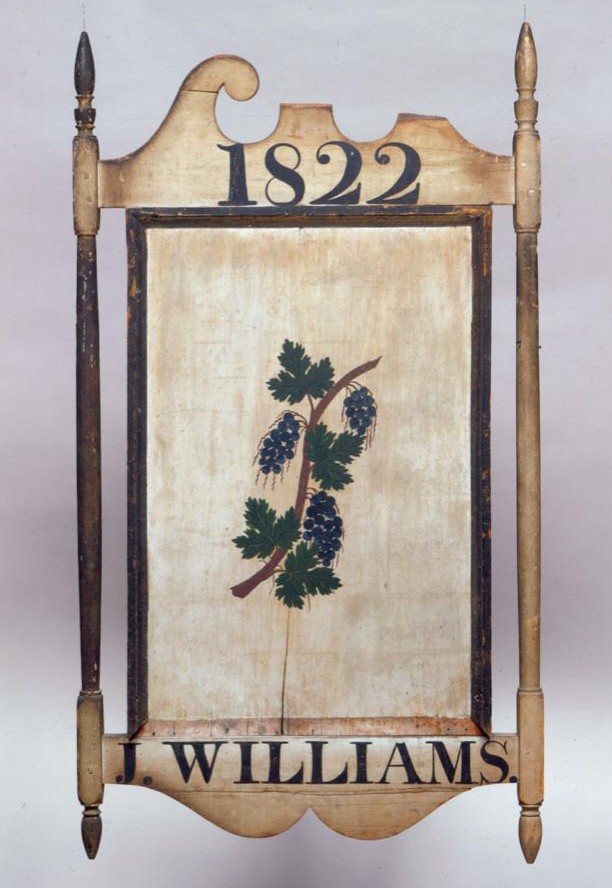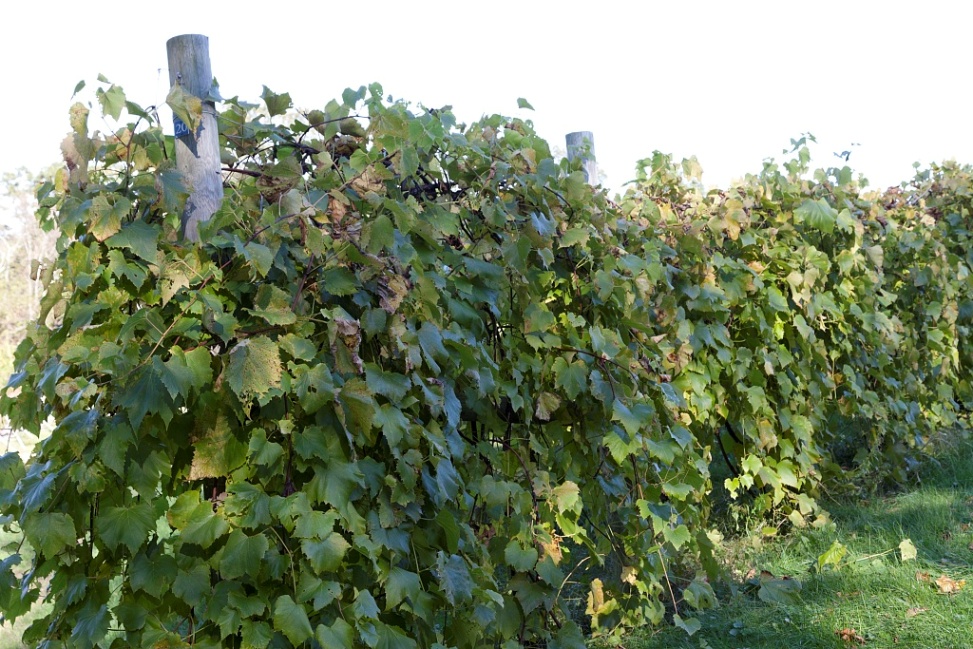By Amy Gagnon
The state’s early English colonists were avid wine drinkers and encouraged its use, believing it to be healthful. Drinking wine, as well as other liquors, was an everyday event. To satisfy this practice, the first settlers experimented in winemaking techniques along the Eastern Seaboard.
The Early History of Winemaking in the State

A tavern sign, Sign of the Grapes, 1822 – Connecticut Museum of Culture and History. Used through Public Domain.
Although native grapes grew in abundance, early hopes of mass winegrowing disappeared partly because of the colonists’ inexperience at cultivating and growing vines appropriate for winemaking. Liquor importation also hampered local production efforts. Supplies of European wine were plentiful, inexpensive, and easily imported. And, rum, already distilled in the New England colonies, had cornered a large share of the market for spirits.
It was not until the 19th century that eastern states, including Connecticut, began to succeed in the practice of viticulture. Two surveys taken in 1859 and 1860 evaluated the wine industry in the United States. The first, written by the British consul in Washington, and the second, the national census of 1860, included statistics that depicted the nation’s first 50 years of successful winegrowing.
The forecast for continued mass production of wine in the US was favorable. Out of the 1,600,000 gallons of wine that the nation’s vineyards produced in 1860, Connecticut contributed 20,000. Admittedly, this amount could not supply a nation of wine drinkers, but it was a good sign for the future of winegrowing in Connecticut. It would not be until the 20th century, however, that viticulture would flourish in the state.
The Science of Winemaking
Viticulture is the science, production, and study of grapes. When grapes are used for winemaking, viticulture is also known as viniculture and is a branch of horticulture. Viticulturists have many duties in vineyards. These include fertilizing and irrigating soil, monitoring and controlling pests and diseases, selecting plants for desirable developmental qualities and the characteristics of their fruit, and harvesting and pruning the fruit and plants. Viticulturists work closely with winemakers and vineyard management, and it is the viticulturist’s job that provides the basis from which winemaking begins.
In the United States, winemaking regions are designated by the Alcohol and Tobacco Tax and Trade Bureau (TTB), a government agency that oversees the regulation of wines sold domestically. Each grape-growing area that earns recognition as an American Viticultural Area (AVA) is distinguished by geographic features and boundaries. As of January 2012, the US boasted just over 200 AVAs.
Connecticut has two American Viticultural Areas: the Western Connecticut Highlands and Southeastern New England. The latter includes parts of Massachusetts, Rhode Island, and, in Connecticut, parts of New Haven, New London, and Middlesex counties. The Western Connecticut Highlands area includes all of Litchfield and parts of Fairfield, New Haven, and Hartford Counties. Connecticut’s climate is one of the best in New England for growing grapes, and both Connecticut appellations use native as well as European hybrid vines to produce exceptional, although different, varieties of wine.
Connecticut Passes Winery Laws
In 1978 Connecticut legislature passed the Farm Winery Act that permitted winery owners to sell their products wholesale and to the public. Soon after, wineries throughout Connecticut began to cultivate vines and grow grapes on a large scale. That same year, Litchfield’s Haight-Brown Vineyard, established in 1975, became the first commercial winery in Connecticut—and the first company in the state to grow Chardonnay and Riesling vines. Shortly after the establishment of Haight-Brown, many vineyards appeared in Connecticut. As of 2012, there are 24 commercial wineries occupying more than 2 million acres throughout Connecticut. Each produces signature and diverse labels for public consumption.
The Connecticut Wine Trail
In 1988 the Connecticut Wine Trail, a state-approved winery- and vineyard-awareness program, gave greater prominence to this agricultural sector. The trail covers an extensive region and winds through a series of historic Connecticut towns, from Litchfield County to the Long Island Sound. Geographically, the route is split into two regions: the eastern and the western trails, each possessing its own distinct characteristics. The vineyards on the wine trail grow a diverse assortment of grapes, including Chardonnay, Merlot, Riesling, and Cabernet Franc. They produce a variety of fermented beverages ranging from dry, barrel-fermented wines to fruitier, sweeter wines. Some produce sparkling vintages, ciders, and wines made from pears, apples, raspberries, and other local fruit.
The wine trail, assembled by 24 members of the Connecticut Vineyard and Winery Association, is one of Connecticut’s most popular tourist activities. Visitors to the trail can explore the western section in the Housatonic Valley and journey to the eastern section of the Connecticut River Valley. Each winery is open to the public and offers tours and wine tastings.
Amy Gagnon works as a content developer for ConnecticutHistory.org at Connecticut Humanities and received her MA in Public History at Central Connecticut State University.









